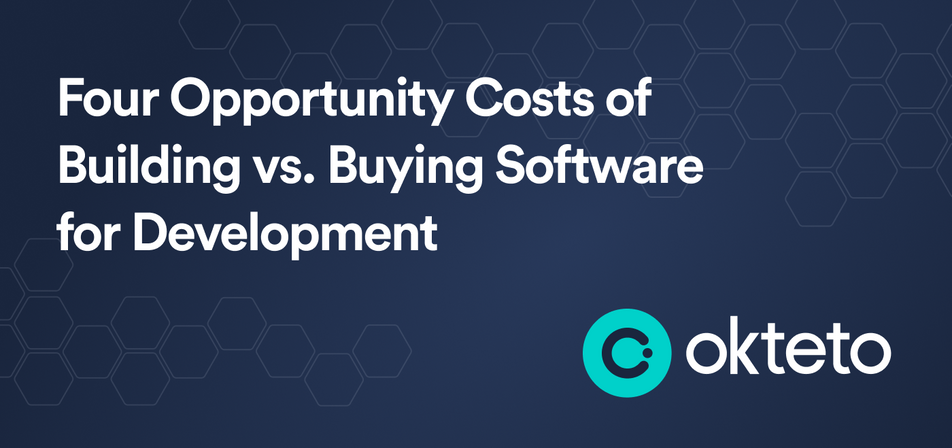Four Opportunity Costs of Building vs. Buying Software for Development

At first glance, creating an internal cloud development experience platform may appear to be a sage business choice. Hey, a custom solution allows teams to manage specifications and control the release process to meet their immediate needs.
That’s pretty cool, right?
However, building an in-house platform also means that your team will be accountable for future development expenditures, ongoing research, maintenance, bug fixes, platform updates, and support. These tasks can be expensive and time-consuming, removing valuable resources from your core business activities.
That’s not so cool.
Remember that things in high-tech move fast. If you’ve got a prospect with unique or urgent needs — and your engineering team must first make modifications to your platform in order to meet this customer's exotic feature requirements — you might lose out on the deal. But a third-party vendor with a suite of out-of-the-box modern development platform features lets you turn disruptive change into business opportunities.
Should You Buy or Build a Development Platform?
The Opportunity Cost of In-house Software Development Tools
When considering building a development platform, it's essential to consider the opportunity costs that come with it. Opportunity cost refers to the potential benefits you might miss by choosing one option over another. Here are some of the opportunity costs that you might encounter when building a development platform:
1. Time and money
Building a development platform takes time, resources, and effort. The opportunity cost spent building the platform could be spent on projects that have a higher ROI. As you think about building your platform, consider this: It took an entire dedicated team of engineers a year to build the first version of a leading development platform vendor. This effort represented around 1 MM in payroll expenses to get the platform up and running. Throw in a few other priorities and distractions, and you're easily looking at 2X that.
2. Preventing Developers from Delivering Value
Building a development platform requires a team of experts with specific skills and knowledge. The developers you devote to building the platform could be better used to design killer cloud applications that will grow your business by driving revenue. That’s a huge opportunity cost because it’s an opportunity lost. Pro Tip: Ask yourself if building in-house software is at the expense of developing, qa, and implementing and rolling-out core features to grow your business. What is the opportunity cost of using your developers to maintain an in-house solution instead of delivering value?
3. Missing Out on Critical Features
You might assume you’ve gained a competitive advantage by building your own platform but ask yourself the following questions:
- Is your feature roadmap comparable to what you get out of the box with a vendor?
- Can you manage multiple moving parts, such as IDEs, Docker, code repos, and endless tooling options?
- Can you connect to another developer's branch on its local frontend without spinning up that instance?
- Can you troubleshoot issues globally across namespaces and shared environments? If the answer to these questions is "no," you may be at a competitive disadvantage.
4. Inability to Pivot Quickly to Seize Big ROI Opportunities
Building a development experience platform can limit your ability to scale quickly and the flexibility to adapt to changing business needs. The inability to pivot fast is itself an opportunity cost as the limitations of your in-house platform could compromise the desire to turn disruptive change into the next big thing. If you need to pivot your strategy or change direction, you might have to invest more time and money into the platform. The technical challenges of building an in-house platform are daunting and the total cost of ownership (TCO) of maintaining the solution often results in sticker shock. Pro Tip: when it comes to scalability and flexibility, ask yourself the following:
- What's the opportunity cost of using your cross-functional resources to provide ongoing bug fixes, maintenance, and platform updates at scale?
- Can you test the code before merging, and can your solution manage multiple microservices in parallel?
- Does your solution provide flexibility to allow developers to use their favorite tools and is it easy for both Kubernetes pros and newbies to collaborate?
The Ultimate Build vs Buy Self Evaluation Guide
The Benefits of Outsourcing Software Development for Dev Platforms
When building, it's essential to consider the opportunity costs. For example, you might miss out on other projects or initiatives with a higher ROI, or your flexibility and scalability might be limited. Therefore, it's crucial to carefully weigh the potential benefits and costs.
Buying a cloud development experience platform can offer several benefits compared to building one in-house. First, it can save significant time and resources, allowing you to market faster. With a pre-built platform, you can immediately start using it rather than spending time and resources developing it from scratch.
Buying offers a tremendous competitive advantage by allowing platform and development engineering teams to bring software to market quickly and efficiently.
